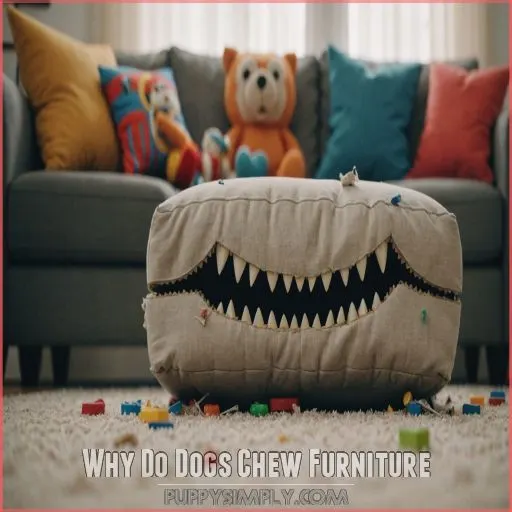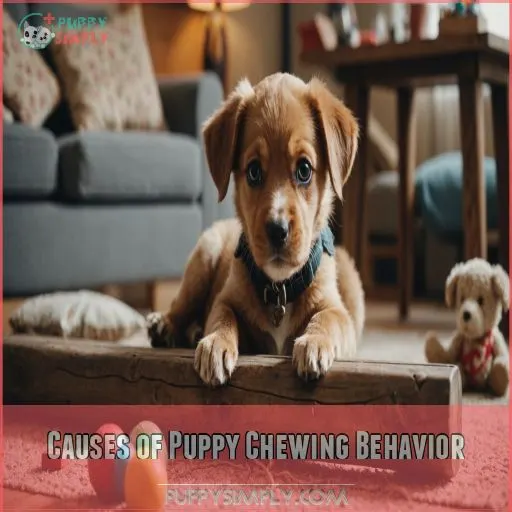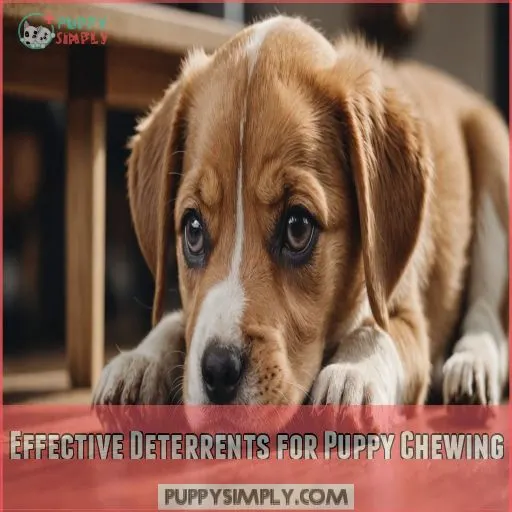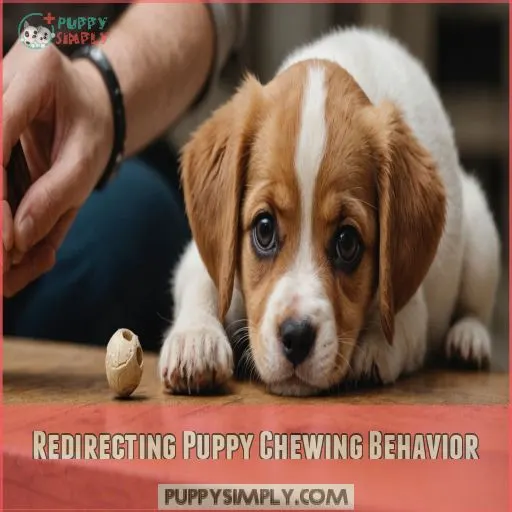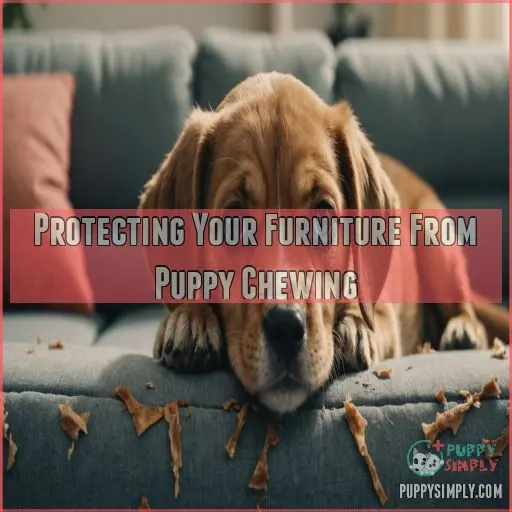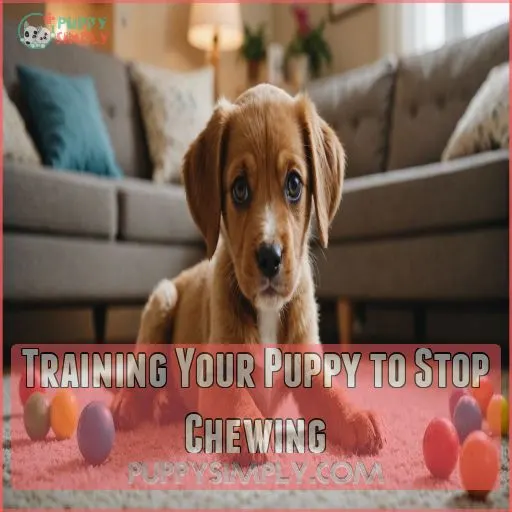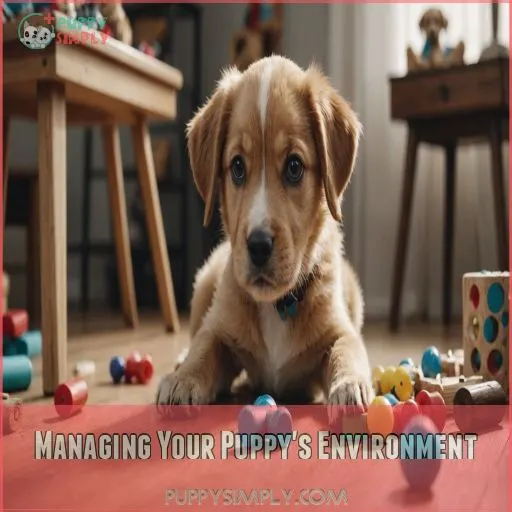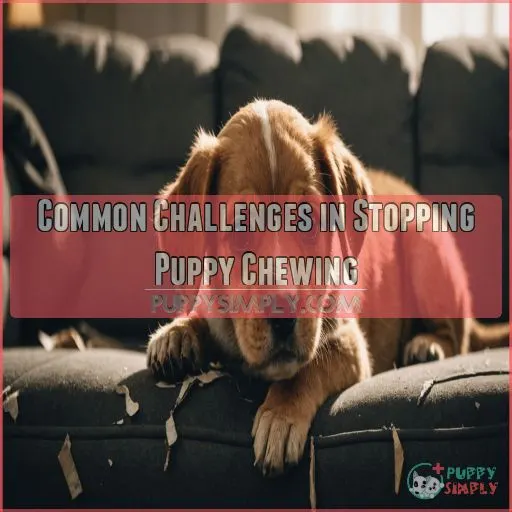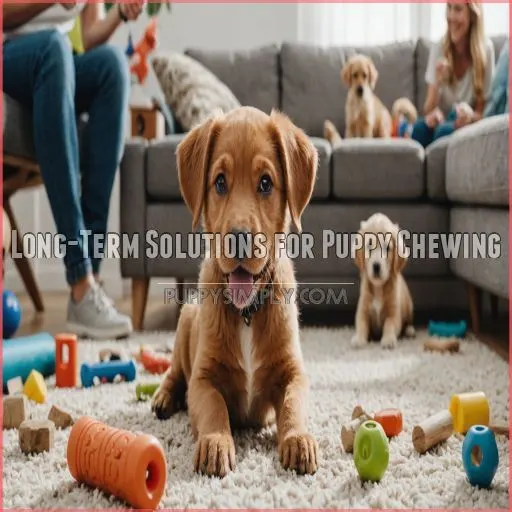This site is supported by our readers. We may earn a commission, at no cost to you, if you purchase through links.
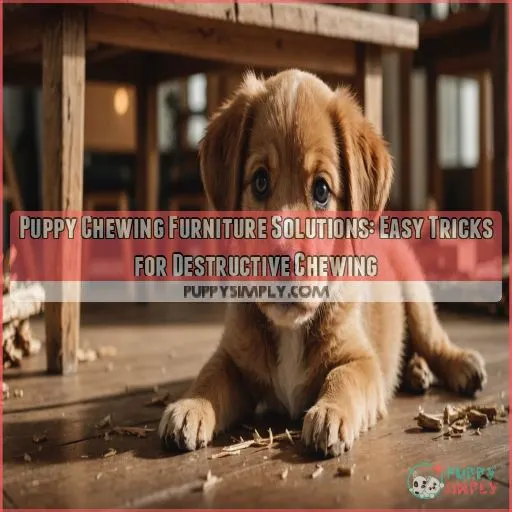 Is your puppy turning your sofa into a chew toy? Don’t fret! Tackling puppy chewing furniture solutions is easier than you think.
Is your puppy turning your sofa into a chew toy? Don’t fret! Tackling puppy chewing furniture solutions is easier than you think.
Start by redirecting your furry friend’s chompers to appropriate chew toys. Frozen Kongs stuffed with treats can work wonders.
Spray furniture with a pet-safe bitter apple solution to make it less appealing. Exercise your pup regularly to burn off that chewing energy.
Remember, consistency is key – always reward good behavior. If Fido’s still going to town on your coffee table, try covering it with a chew-resistant material.
Who knew saving your furniture could be so doggone simple? But wait, there’s more to explore when it comes to puppy-proofing your home.
Table Of Contents
- Key Takeaways
- Why Do Dogs Chew Furniture
- Causes of Puppy Chewing Behavior
- Effective Deterrents for Puppy Chewing
- Redirecting Puppy Chewing Behavior
- Protecting Your Furniture From Puppy Chewing
- Training Your Puppy to Stop Chewing
- Managing Your Puppy’s Environment
- Choosing the Right Chew Toys for Your Puppy
- Common Challenges in Stopping Puppy Chewing
- Long-Term Solutions for Puppy Chewing
- Frequently Asked Questions (FAQs)
- How do you get a dog to stop chewing on furniture?
- Can dogs chew furniture?
- Why does my dog chew my furniture?
- How do I Stop my Dog from chewing?
- How long does the puppy teething phase typically last?
- Can certain breeds be more prone to furniture chewing?
- Are there safe, natural alternatives to commercial chew toys?
- How can I puppy-proof electrical cords and wiring?
- Should I use positive reinforcement or punishment for chewing?
- Conclusion
Key Takeaways
- You’re not alone in the furniture-chewing chaos! Understand your pup’s motives—whether it’s teething, boredom, or anxiety—and you’ll be halfway to solving the problem.
- Turn your home into a puppy paradise with the right chew toys. Mix it up with frozen Kongs, durable rubber toys, and puzzle feeders to keep those chompers busy and your furniture safe.
- Consistency is your secret weapon. Stick to your training, use positive reinforcement, and remember: Rome wasn’t built in a day, and neither is a well-behaved pup!
- Don’t forget to puppy-proof like a pro. From bitter sprays to furniture guards, create a chew-free zone that’s as fun for your furry friend as it is safe for your sofa.
Why Do Dogs Chew Furniture
If your favorite chair suddenly turns into your puppy’s chew toy, it’s not just bad luck—there’s usually a reason behind their destructive habits, often related to teething discomfort and natural biting instincts
.
Dogs often chew furniture due to teething, boredom, or anxiety, so understanding why they’re doing it’s the first step to redirecting that energy into something less destructive.
Teething Puppies and Furniture Chewing
Teething puppies often turn furniture into chew toys, seeking relief from their aching gums.
Imagine your pup as a tiny carpenter trying to remodel your home!
Timing is everything; with a keen eye on teething timelines, offer safe chewing alternatives like frozen dog chew toys, such as those found in dog toy subscription boxes
.
They soothe young gums while saving your sofa legs from becoming puppy art projects, a relief to those who know the value of a good puppy art projects
Separation Anxiety and Furniture Chewing
Does your pup chew furniture like it’s their second job? Separation anxiety might be the culprit.
Try these:
- Identify triggers for separation anxiety with behaviorist advice.
- Implement calming techniques, like leaving a worn t-shirt.
- Consider crate training to create a safe space.
- Consult your vet about anxiety meds if needed.
You’ll soon outsmart that chewing mischief!
Boredom and Lack of Exercise
A pup might chew furniture like it’s their full-time job simply because they’re bored or under-exercised.
Combat dog boredom by ensuring your furry friend gets plenty of mental stimulation and exercise.
You can provide them with durable dog toys made of tough materials like nylon, rubber, or reinforced plastic to curb destructive behaviors, such as those found in the best dog toys for aggressive chewers.
Establish a playtime routine, use puzzle toys, and make dog park visits part of your routine to prevent boredom caused by a natural predisposition to aggressive chewing.
Keep things lively with interactive toys and rewarding dog treats.
Pain and Medical Issues
Ouch, your pup’s furniture chewing could be a sign of pain or an underlying medical issue. Check for signs like limping, swelling, or sensitivity. If you suspect something’s wrong, don’t wait – schedule a vet visit right away.
They can identify the source and recommend safe pain relief or treatment options to get your furry friend feeling better, and you can find some healthy treat options like these to help keep your dog happy and healthy
.
- Limping or favoring a paw
- Swelling or redness in joints
- Sensitivity when touched in certain areas
- Sudden changes in behavior or appetite
Communication and Attention Seeking
Your puppy might feel like a vocal mime, using furniture-chewing to say, "Look at me!"
It’s a classic case of communication and attention-seeking.
Learn to read their body language, and tackle those destructive behaviors with positive reinforcement and dog training like using a release command
.
Offer a chew toy or kong toy to divert their focus from furniture, curbing puppy barking and whining effectively (Source).
Causes of Puppy Chewing Behavior
Puppies chew everything from shoes to sofas and it’s not just to test your patience.
By understanding what drives your puppy’s chomping spree, you can tackle the root causes, such as the need for exercise, comfort, or relief from teething pain.
You can then keep your furniture intact.
Identifying Underlying Reasons for Chewing
Understanding why your furry friend is turning your couch into a chew toy is half the battle.
Puppies often chomp away due to teething pain or boredom. It’s like they’re saying, "Hey, my gums hurt!" or "I’m bored out of my mind!"
Stress can also lead to destructive chewing. By identifying these triggers, you’ll be better equipped to nip the problem in the bud and keep your furniture intact.
Managing Separation Anxiety
When your pup turns into a furniture-munching machine the moment you leave, it’s time to tackle separation anxiety head-on.
Start by identifying anxiety triggers and gradually desensitize your furry friend to your departures . Try crate training or use calming aids to create a safe space.
Consider enlisting dog walkers or scheduling puppy play dates to keep your pooch occupied. With patience and consistency, you’ll transform your anxious chewer into a relaxed homebody, turning them into a relaxed homebody.
Providing Adequate Exercise and Stimulation
Just as a cooped-up kid might bounce off the walls, a bored pup’ll chew up your couch!
Nip that destructive behavior in the bud with a tail-wagging playtime schedule. Mix it up with dog park visits, interactive toys, and outdoor adventures.
Mental challenges are like chili pepper spray for boredom – they’ll keep your furry friend’s mind occupied and your furniture intact. Remember, a tired pup is a good pup!
Addressing Pain and Medical Issues
Your pup’s furniture-chewing frenzy might be more than just a phase—it could be a cry for help. Don’t brush off those gnawed table legs; they might signal underlying health issues.
Keep an eye out for these telltale signs:
- Wincing when you pet certain areas
- Reluctance to play fetch like they used to
- Pawing at their mouth more than usual
Regular vet check-ups are your secret weapon against hidden pain. Remember, a happy, healthy pup is less likely to turn your couch into a chew toy!
Effective Deterrents for Puppy Chewing
Tired of your pup turning your favorite chair into a chew toy?
Let’s explore some clever, easy-to-use deterrents that’ll make your furniture less tempting.
Save your sanity in the process.
Apple Cider Vinegar Spray Solution
Put the kibosh on puppy chewing with a trusty apple cider vinegar spray.
Mix one part vinegar with five parts water for a safe, effective deterrent . Test it on a hidden spot first to avoid furniture damage.
Spritz problem areas regularly, but don’t spray your furry friend directly. This tangy solution will have your pup saying, "No thanks!" to your favorite chair in no time, thanks to the use of apple cider vinegar spray.
Mild Chili Pepper Spray Deterrent
Looking for a spicier solution? Whip up a mild chili pepper spray to keep Fido’s chompers at bay. Mix one tablespoon of mild chili powder with a quart of water in a spray bottle. Shake well and apply lightly to furniture hotspots.
Remember these safety precautions:
- Test on a hidden spot first
- Avoid Fido’s eyes and nose
- Store out of reach
- Discontinue if your pup shows discomfort
This DIY recipe packs a punch without breaking the bank!
Black Pepper Rub for Furniture Protection
While chili powder packs a punch, black pepper offers a milder kick to keep furniture safe from puppy teeth.
This natural remedy is a snap to whip up and apply. Let’s spice things up with a pepper rub that’ll have your furry friend thinking twice before chomping on your favorite chair!
| Ingredient | Amount |
|---|---|
| Black pepper | 2 tablespoons |
| Water | 1 cup |
| Spray bottle | 1 |
| Cotton cloth | 1 |
Mix, shake, and dab on trouble spots. Your pup’s nose will thank you, but your furniture? It’ll be sitting pretty!
Lemon Juice Solution for Chewing
You can turn your pup’s chewing habits sour with a zesty lemon juice solution.
Mix equal parts lemon juice and water in a spray bottle . Apply this citrusy concoction to furniture your furry friend fancies.
The tart taste will make them think twice before taking another bite.
Don’t worry, it’s safe for your pooch and won’t damage your belongings.
Just remember to reapply regularly for maximum deterrent power.
Soap Rub for Unwanted Chewing
Three magic words: soap rub trick! Grab a bar of Ivory soap and rub it on your favorite chair legs, table edges, and even those tempting IKEA pine pieces .
Your pup’s reaction? Pure comedy gold! They’ll turn tail faster than you can say "fetch."
Reapply weekly to keep your furniture safe and your furry friend’s taste buds in check. Just remember, safety first – avoid scented or antibacterial soaps that might upset your pup’s tummy.
Redirecting Puppy Chewing Behavior
Your pup’s chewing your favorite chair?
Don’t panic – redirecting their chomping urges is easier than you think.
With the right toys, a cozy setup, and some positive reinforcement, you’ll have your furry friend gnawing on appropriate items in no time.
Providing Appropriate Chew Toys and Treats
In the face of a furniture-munching pup, redirecting their chewing instincts can be a game-changer.
Let’s turn those sharp little teeth into allies with these puppy-approved chew toys and treats:
- Durable rubber Kongs stuffed with frozen peanut butter
- Natural chews like bully sticks or antlers
- Puzzle toys that dispense treats for mental stimulation
- Homemade frozen veggie popsicles
- Rotating toy collection to keep things fresh and exciting
Remember, a chewing pup is just a bored pup in disguise!
Creating a Fun and Comfortable Environment
Countless pups transform into furniture-chomping monsters when boredom strikes. Don’t fret!
Create a puppy paradise with safe spaces and cozy corners. Scatter boredom busters like puzzle toys around the house, keeping your furry friend’s mind occupied.
During playtime, engage in tug-of-war or fetch to burn energy. Remember, a tired pup is less likely to redecorate your sofa.
By providing enrichment, you’ll keep those pearly whites off your prized possessions.
Using Frozen Kongs for Distraction
Frozen Kongs: your secret weapon against furniture-chewing puppies. These icy treats will keep your furry friend busy for hours, saving your couch from becoming a chew toy. Since 80% of dogs chew on inappropriate items, it’s important to provide them with a suitable alternative. Additionally, puppies often chew due to teething pain from new teeth coming in, making the soothing feeling of frozen Kongs a great relief.
- Mix kibble with peanut butter or yogurt for a tasty Kong filling
- Freeze overnight for longer-lasting entertainment
- Rotate Kong sizes to keep things interesting
Remember, a busy pup is a happy (and less destructive) pup!
Implementing Positive Reinforcement Training
Positive reinforcement isn’t just a treat-and-retreat game; it’s your secret weapon against furniture faux pas!
While Kongs keep pups busy, let’s teach them what’s chew-worthy.
Catch your furry friend in the act of gnawing on approved toys and shower them with praise. It’s like throwing a puppy party every time they make the right choice!
Consistency is key, so keep those rewards coming. Soon, your pup will be furniture-friendly and tail-waggingly happy.
Protecting Your Furniture From Puppy Chewing
You’ve caught your pup gnawing on the couch leg again, and you’re at your wit’s end.
Don’t worry – we’ve got some clever tricks up our sleeve to protect your furniture and keep your sanity intact.
All while helping your furry friend learn better chewing habits.
Using Durable and Chew-Resistant Materials
While your pup’s teething phase might feel like a furniture apocalypse, don’t throw in the towel just yet!
Opt for chew-resistant materials to outsmart those chompers. Leather’s durability trumps microfiber, while canvas offers budget-friendly protection.
For a DIY approach, try wrapping furniture legs in aluminum foil – it’s like kryptonite for puppy teeth!
Remember, "an ounce of prevention is worth a pound of cure" in terms of preserving your favorite pieces.
Applying Bitter Sprays for Deterrence
Imagine your favorite armchair transformed into a giant, unappetizing lemon! That’s the magic of bitter sprays. You’ll find various types, from vinegar-based DIY solutions to store-bought options.
Apply sparingly to chew-prone areas, but always test on a hidden spot first. Remember, safety first – avoid your pup’s eyes and nose.
If Fido still seems interested, try alternating with different deterrents. With consistency, you’ll outsmart that four-legged furniture connoisseur in no time!
Installing Furniture Guards and Covers
Let’s face it, bitter sprays aren’t always enough to keep your furniture safe from those puppy teeth. It’s time to bring out the big guns: furniture guards and covers! These clever contraptions are like armor for your beloved couch.
- Choose your weapon: Plastic guards, fabric covers, or DIY solutions
- Place guards strategically: Focus on corners and edges
- Maintain your defenses: Clean and adjust regularly
- Blend with style: Pick guards that complement your décor
Utilizing Natural Repellents for Chewing
Nature’s arsenal can be your secret weapon against puppy chewing. You’ve got a smorgasbord of DIY repellents right in your kitchen! Whip up a citrus spray or cayenne pepper solution to keep your furniture safe . But remember, effectiveness varies, so don’t put all your eggs in one basket.
| Repellent | Effectiveness | Safety Concerns |
|---|---|---|
| Citrus | High | Low |
| Vinegar | Medium | Low |
| Cayenne | High | Moderate |
| Coffee | Low | Low |
| Mustard | Medium | Low |
Try these alternatives, but keep your sense of humor – your pup might just develop a taste for spicy furniture!
Training Your Puppy to Stop Chewing
You’ve caught your pup red-handed (or should we say red-pawed?) chewing on your favorite chair again.
Don’t worry – with some basic obedience commands, positive reinforcement, and a dash of patience,
you’ll have your furry friend chewing on their toys instead of your furniture in no time.
Basic Obedience Commands for Chewing
Now that you’ve puppy-proofed your furniture, it’s time to teach your furry friend some manners.
Basic obedience commands are your secret weapon against destructive chewing. Basic obedience commands are essential in this process.
Start with "Leave it" when your pup eyes that tempting table leg. If they’ve already snagged something, a firm "Drop it" can work wonders.
"Off" keeps them from jumping on furniture, while "Quiet" and "Place" help manage overall behavior.
Remember, consistency is key in this chewing chess game, and mastering commands such as "Drop it" can make a significant difference.
Positive Reinforcement Techniques for Good Behavior
You’ve taught your pup to "leave it," but the real magic happens when you catch them being good.
Imagine your furry friend’s tail wagging as you shower them with praise for chewing their toy instead of your shoe.
That’s the power of positive reinforcement. Use a clicker or a cheerful "yes!" to mark the exact moment of good behavior, then follow up with a tasty treat.
It’s like giving your pup a standing ovation for their stellar performance.
Consistency and Patience in Training
Your pup’s journey to furniture-friendly behavior isn’t a sprint—it’s a marathon.
Consistency is key, so stick to your guns even when those puppy eyes beg for mercy .
When training setbacks occur, take a deep breath and remember: patience pays off.
Keep wielding that positive reinforcement like a pro, and you’ll see long-term success.
Think of it as teaching your furry friend a new trick—it takes time, but the tail-wagging results are worth it!
Managing Your Puppy’s Environment
You’re the boss of your pup’s world, so it’s time to puppy-proof like a pro.
Set your furry friend up for success by creating a chew-free zone that’s as fun for them as it’s safe for your furniture.
Supervising and Monitoring Chewing Behavior
Once you’ve got the basics down, it’s time to play detective.
Keep your eyes peeled for those telltale signs of chewing stress – restlessness or sudden interest in forbidden objects.
Stay one step ahead by puppy-proofing rooms and using baby gates.
Think of yourself as a chew-toy DJ, always ready to swap out that shoe for an appropriate toy.
It’s like a game of "hot potato" – but with less scorched fingers!
Rotating Toys and Chews for Variety
Keeping a watchful eye on your pup’s chewing habits? Let’s shake things up!
Imagine your puppy’s toy box as a treasure chest. Every week, swap out the old for the new – it’s like Christmas morning for your furry friend!
This toy rotation schedule keeps their tail wagging and their chompers off your furniture. Plus, it’s a great way to check for chew toy safety.
Who knew variety could be so doggone fun?
Limiting Access to Undesirable Areas
Now that you’ve got a toy rotation system in place, let’s tackle the art of puppy-proofing your home.
Think of it as creating a puppy paradise with boundaries. Set up baby gates to block off restricted areas, turning certain rooms into safe havens.
Establish designated chew zones where your furry friend can gnaw to their heart’s content.
Remember, a well-managed environment is like giving your pup a map to success – they’ll know exactly where they can let loose and where they should mind their manners.
Choosing the Right Chew Toys for Your Puppy
You’re on a mission to save your furniture from those tiny teeth, and picking the right chew toys is your secret weapon.
Let’s get you equipped with some puppy-approved alternatives that’ll keep your furry friend busy and your couch in one piece.
Selecting Durable and Long-Lasting Toys
Out of the toy box and into the fray, selecting durable chew toys that withstand dog chewing wood is really important for your puppy’s safety and your sanity
.
Opt for tough rubber toys like KONG, which can withstand even the most determined chewers.
Consider your pup’s chew strength when choosing materials. Mix it up with a variety of textures to keep things interesting.
Stick to reputable brands known for their quality and safety. Remember, a happy chewer is a happy pup with tough rubber toys and a variety of textures.
Avoiding Toys With Small Parts or Choking Hazards
You’ve picked out some tough toys, but let’s talk about keeping your furry friend safe.
Size matters in terms of toy safety! Avoid anything that could fit past your pup’s front teeth – it’s a choking risk waiting to happen.
Think of it like this: if it’s small enough to swallow, it’s too small to play. Stick to larger, puppy-proof toys and you’ll both sleep easier at night with a choking risk.
Introducing New Toys for Variety and Stimulation
Variety is the spice of life, especially for your chew-happy pup! Keep those chompers occupied with a rotating cast of toys. Remember, safety first – choose chew toys that’ll stand up to your furry friend’s enthusiasm.
This boredom-busting strategy will have your furniture breathing a sigh of relief!
- Swap out toys weekly to maintain interest
- Mix textures: rubber, rope, plush for sensory enrichment
- Introduce puzzle toys for mental stimulation
- Freeze treats in toys for longer-lasting entertainment
Common Challenges in Stopping Puppy Chewing
You’re not alone if your puppy’s chewing habit is driving you up the wall, especially for breeds like the Bichon Frise behavior
.
From separation anxiety to teething troubles, we’ll tackle the most common hurdles you’ll face when trying to curb your furry friend’s destructive chewing.
We’ll equip you with practical solutions to keep your furniture safe.
Overcoming Separation Anxiety and Stress
Separation anxiety can turn your pup into a furry wrecking ball.
Don’t fret! Start with crate training, making it a cozy den your dog loves. Use calming aids like pheromone diffusers or anxiety wraps.
Gradually increase alone time, leaving calming signals like a worn t-shirt. Consider a dog walker for midday breaks.
Remember, patience is key – Rome wasn’t built in a day, and neither is a calm, furniture-friendly pup!
Managing Teething Puppies and Chewing
Teething puppies can turn your home into a chew-fest! But don’t worry, you’ve got this. Freeze rubber toys to soothe those sore gums. It’s like giving your pup a cool, soothing popsicle for their mouth.
Remember, crate training is a great way to keep your puppy safe and secure, especially when you’re not around to supervise.
Rotate toys to keep things exciting – nobody likes last year’s leftovers. Remember, your furniture isn’t fair game. Use bitter sprays to make them less tempting.
With patience and the right tools, you’ll navigate this toothy phase like a pro!
Addressing Boredom and Lack of Exercise
Is your pup turning your couch into confetti out of sheer boredom? Don’t fret!
Amp up their daily routine with interactive toys and puzzle feeders to keep their minds buzzing.
Squeeze in brisk walks or frisbee sessions to burn that excess energy .
Remember, a tired pup is a happy (and less destructive) pup!
Mix it up with doggy playdates – nothing beats a good romp with furry friends.
Long-Term Solutions for Puppy Chewing
You’ve made it through the tough chewing phase, but don’t let your guard down just yet.
Stick to your training guns and keep those chew toys coming.
It’s the secret sauce for a furniture-friendly pup in the long run.
Maintaining Consistency in Training
You’ve tackled the tough challenges, now let’s keep that momentum going! Maintaining consistency is your secret weapon. Think of it as a marathon, not a sprint.
- Stick to your guns: Don’t let those puppy-dog eyes sway you from the rules.
- Make training a daily ritual: Consistency breeds success.
- Celebrate small wins: A tail wag for progress keeps you both motivated.
Remember, Rome wasn’t built in a day, and neither is a well-behaved pup!
Continuously Providing Ade
The secret to long-term chewing success? Keep your pup’s chompers happily occupied!
Provide adequate exercise to tire out those puppy muscles, and mix in mental stimulation with puzzle toys.
Create a safe environment by puppy-proofing your home, removing tempting items from reach.
Use positive reinforcement and consistent training to reinforce good habits.
Remember, a tired puppy is a well-behaved puppy – and less likely to turn your sofa into a chew toy!
Frequently Asked Questions (FAQs)
How do you get a dog to stop chewing on furniture?
Furniture-ming pups got you frazzled? Redirect their chompers to appropriate chew toys.
Spray bitter apple on no-go zones, and freeze rubber toys for teething relief.
Remember, a tired pup’s less likely to destroy your couch!
Can dogs chew furniture?
Imagine this: your favorite armchair, now sporting tooth marks like battle scars.
Yes, dogs can chew furniture, often due to teething, boredom, or anxiety.
Don’t fret! With proper training and alternatives, you’ll save your sofa and keep Fido happy.
Why does my dog chew my furniture?
Ever caught your pup gnawing on your favorite chair?
They’re likely teething, bored, or anxious. It’s their way of exploring or soothing themselves.
Don’t fret! With the right chew toys and training, you’ll save your furniture and keep Fido happy.
How do I Stop my Dog from chewing?
Your sofa’s not a chew toy, but your pup doesn’t know that!
Redirect their chomping to appropriate toys.
Use deterrent sprays on furniture.
Keep them engaged with puzzle feeders.
Remember, a tired dog’s less likely to gnaw your stuff.
How long does the puppy teething phase typically last?
Brace yourself for 4-5 months of puppy teething chaos.
It kicks off around 5-6 weeks and wraps up by 6-7 months.
Don’t fret, though – with the right chew toys, you’ll both survive this toothy adventure.
Can certain breeds be more prone to furniture chewing?
Some pups are ‘furniture enthusiasts.’
While any dog can nibble, Labradors, Golden Retrievers, and Jack Russells often top the list. But remember, it’s more about individual personality than breed.
Provide chew toys and stay vigilant to protect your couch!
Are there safe, natural alternatives to commercial chew toys?
Ditch synthetic chews for safe, natural alternatives.
Try frozen Kongs stuffed with peanut butter, dental chews approved by vets, or rubber bones with textured surfaces.
These options keep your pup entertained while promoting dental health.
They can serve as a suitable replacement for synthetic products.
Try using natural alternatives for your pet’s overall well-being.
How can I puppy-proof electrical cords and wiring?
Did you know 90% of puppies chew on cords? Don’t let your fur-baby become a statistic!
Cover wires with split loom tubing, use bitter apple spray, and keep cords out of reach.
It’s a shocking solution that’ll keep tails wagging safely! (Source)
Should I use positive reinforcement or punishment for chewing?
Positive reinforcement wins hands down!
Reward your pup for chewing the right things.
It’s like teaching a kid to color on paper, not walls.
You’ll teach your pup to behave without fear, and your furniture will thank you (Source).
Conclusion
Will your furniture survive the puppy phase? With these puppy chewing furniture solutions, you’re well-equipped to tackle the challenge.
Remember, consistency is key. Redirect, reward, and repeat. Your pup’s not out to destroy your home – they’re just exploring their world.
Stay patient and keep at it. Before you know it, your furry friend will outgrow this phase, leaving your furniture intact and your bond stronger than ever.
Now go give that little rascal a belly rub – they’ve earned it!

